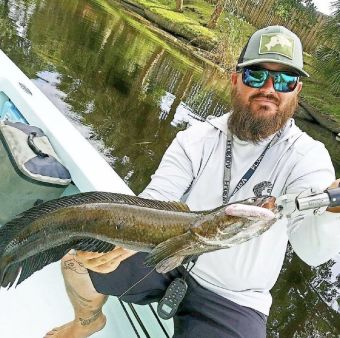Our charter plane from Manaos, Brazil, had just landed at the Barcelos landing strip, a small and colorful town on the giant Rio Negro coast. We had boat bags, rod tubes, lots of water bottles and high expectations as we boarded the boat that would take us deep into the Amazon jungle. The goal was to arrive at the Colombian border with Brazil and fish the Rio Negro for seven days, searching for the amazing Peacock Bass. It was also a fantastic opportunity to try the new Solar rods, and after talking with T&T we arranged a very effective shipment to get them right before our departure.
After a ride to the house boat during the night, I went down to get a tasty Brazilian coffee and rig my rods and reels, all while watching one of the most incredible sunrises that I can remember. My fishing partners and I were pretty impressed when we took the new Solar # 8 weight out of the rod tube…it was smiles all around as the flawless finish on the rods was revealed, and we all agreed that such fine work is a rare thing. We rigged Solar eight and nine-weights, along with one TNT series eleven-weight rod in case we reached the giant arapaimas waters. I believe an eight or nine-weight rod is just perfect for Peacocks, even for 10 to 15 pounders. The rod needs to have the power to fight a big fish in heavy cover, but still be comfortable enough to make hundreds of long casts with 7-inch flies between the trees. I can see the difference after casting all day long in over 95 degree temperatures, for sure any arm will appreciate the wonder of a well designed rod under these tough fishing conditions.
I was ready for my first morning in the Northern Amazon – the three rods on the skiff, extra lines and line dressing, lots of flies and a cooler filled with plenty of drinks. A little talk with my native guide about casting distances and boat positions, and a minute later I found myself surrounded by unbelievably tall trees, blue parrots, amazon dolphins and noisy monkeys…what a trip!!!
The skiff took us up a very small stream covered by hundreds of trees, so that in a few seconds I couldn’t see the light blue sky and we were riding the boat in a kind of green tunnel. My guide and new friend Seka told me there was a pond with nice Peacocks at the end of the stream that we should try. When we arrived the water was oily quiet and I was ready at the front of the boat. Engine off and push pole ready, Seka told me to cast 40 feet to my right and as deep as I can into the trees. After the fly landed, I made a few strips and just like in my dreams a huge wave started to follow the streamer. The water exploded and the fight was on, and a few minutes later the Solar 8-weight was ready for a picture with its first amazing Peacock Bass.
The rest of the morning was pretty similar on the fishing side, we caught about a dozen nice bass plus other kinds of colorful cichlids in the Peacock Bass family. The Solar was a pleasure to use, easy to load with any amount of line out of the rod tip, super accurate for casting among the trees and a powerful butt section to fight big fish. It also has one of the most comfortable cork grips I’ve ever used, a big thing considering hours of non-stop casting under extreme temperatures with sweaty hands.
The rest of the week was just a pure fishing avalanche, we couldn’t count all the fish landed – the guides said we were over 1200 nice Peacocks plus a variety of other Amazon species. In the evenings we shared photos and a lot of funny stories with our fishing partners, along with great food and a really unique atmosphere in the still pristine waters of the Rio Negro, way deep in the Amazon.
In my opinion the Solar is one of the most versatile fly rods ever made – any serious fly fishermen should consider having one or two Solar in their arsenal. It is a must for Saltwater applications but has a tremendous potential for freshwater challenges like Peacock Bass, Freshwater Dorado and Payaras in South America, or even Tiger fish in Africa – the Solar does it all.


















